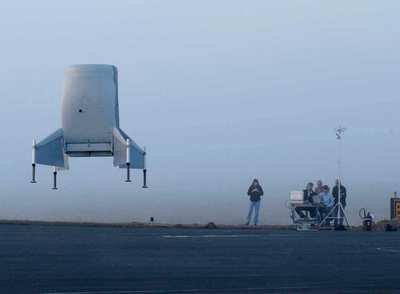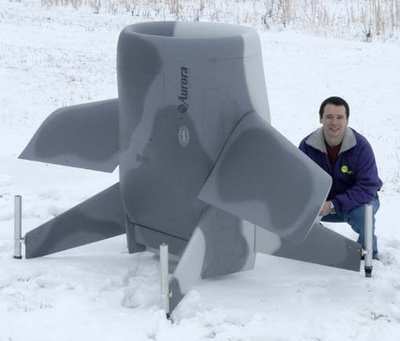Thu, Sep 11, 2003
Aurora Demonstrates Potential for a New Breed of Unmanned
Aircraft
 Aurora Flight Sciences Corporation
has announced the successful first flight of its unique
GoldenEye-100 unmanned aerial vehicle (UAV). During the early
morning hours on Monday, the barrel-shaped autonomous vehicle
executed a smooth vertical take-off and transition to a stable
hover well above the ground-hugging mist at the Manassas Regional
Airport in Virginia. "This demonstration completes a key milestone
in our development program," according to Carl Schaefer,
GoldenEye-100 Program Manager. "It confirms the robustness of
flight control systems and other key technologies in this unique
autonomous system."
Aurora Flight Sciences Corporation
has announced the successful first flight of its unique
GoldenEye-100 unmanned aerial vehicle (UAV). During the early
morning hours on Monday, the barrel-shaped autonomous vehicle
executed a smooth vertical take-off and transition to a stable
hover well above the ground-hugging mist at the Manassas Regional
Airport in Virginia. "This demonstration completes a key milestone
in our development program," according to Carl Schaefer,
GoldenEye-100 Program Manager. "It confirms the robustness of
flight control systems and other key technologies in this unique
autonomous system."
GoldenEye features unconventional performance that enables it to
take-off and land vertically, like a helicopter, then level off
into horizontal flight by virtue of rotating wings. This provides
users with access to a bird's-eye- view of hard to reach areas. Its
engine, known as a ducted-fan, is a propeller shrouded within a
cylindrical body -- a design that integrates advanced lightweight
structures and innovative flight controls to achieve the remarkable
performance. A key subsystem that contributed to flight success is
the GuideStar(TM) flight control system developed by Aurora's
sister company, Athena Technologies.

The GoldenEye-100 has been tailored as an affordable military or
civilian UAV for low-altitude reconnaissance, surveillance or
target acquisition missions. GoldenEye-100 stands 5.5 feet tall
with a gross takeoff weight of 150 pounds. The aircraft can cruise
up to four hours with a range of more than 500 miles at a maximum
speed of 160 knots.
In addition to the 150-pound vehicle, Aurora is developing a
smaller, 16- pound derivative called GoldenEye-50. Aurora plans to
build multiple GoldenEye-50s for homeland security applications and
expansion of the rapid flight envelope of the ducted-fan vehicle
class. This includes transition from hover to horizontal flight and
high-speed dash performance.

"This was an outstanding execution of first flight for this
unique surveillance tool," said Aurora president John Langford, "a
tool we see as playing a key role in the company's future." Aurora
was founded in 1989 to develop affordable robotic aircraft for
global climate change research. Aurora Flight Sciences is a leading
supplier of unmanned air vehicle designs, components, and flight
services for government, industry, and academic clients. Aurora
operates facilities in Virginia, West Virginia, and California. The
company specializes in the design and production of high-altitude
UAVs, and is a major supplier of composite structures for Global
Hawk and other aircraft.
More News
From 2023 (YouTube Edition): New Propulsion Scheme Optimized for AAM Applications Founded in 2017 by Eric Bartsch, Pat Anderson, and Erik Lindbergh (grandson of famed aviation pion>[...]
During The Initial Climb, The Engine Began To Operate Abnormally And, After About Three Seconds, Experienced A Total Loss Of Power On October 29, 2025, about 1820 Pacific daylight >[...]
Aero Linx: Women in Aviation International Women in Aviation International is the largest nonprofit organization that envisions a world where the sky is open to all, and where avia>[...]
“We’ve paid for the cable line’s repair for the customer and have apologized for the inconvenience this caused them...” Source: Some followup info from an A>[...]
“We have long warned about the devastating effects of pairing optimization. Multiple times over many months, we highlighted how schedule manipulation, unbalanced schedules, a>[...]
 Classic Aero-TV: VerdeGo Debuts VH-3 Hybrid-Electric Powerplant
Classic Aero-TV: VerdeGo Debuts VH-3 Hybrid-Electric Powerplant NTSB Prelim: Grumman American Avn. Corp. AA-5B
NTSB Prelim: Grumman American Avn. Corp. AA-5B ANN's Daily Aero-Linx (12.02.25)
ANN's Daily Aero-Linx (12.02.25) Aero-News: Quote of the Day (12.02.25)
Aero-News: Quote of the Day (12.02.25) Aero-News: Quote of the Day (12.03.25)
Aero-News: Quote of the Day (12.03.25)





